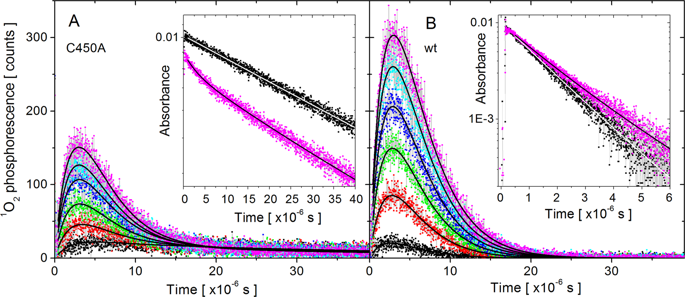Scientific Reports ( IF 3.8 ) Pub Date : 2020-03-05 , DOI: 10.1038/s41598-020-60861-2 Martina Petrenčáková 1 , František Filandr 2 , Andrej Hovan 1 , Ghazaleh Yassaghi 2 , Petr Man 2 , Tibor Kožár 3 , Marc-Simon Schwer 4 , Daniel Jancura 1, 3 , Andreas Plückthun 4 , Petr Novák 2 , Pavol Miškovský 3, 5 , Gregor Bánó 1, 3 , Erik Sedlák 3

|
Flavin mononucleotide (FMN) belongs to the group of very efficient endogenous photosensitizers producing singlet oxygen, 1O2, but with limited ability to be targeted. On the other hand, in genetically-encoded photosensitizers, which can be targeted by means of various tags, the efficiency of FMN to produce 1O2 is significantly diminished due to its interactions with surrounding amino acid residues. Recently, an increase of 1O2 production yield by FMN buried in a protein matrix was achieved by a decrease of quenching of the cofactor excited states by weakening of the protein-FMN interactions while still forming a complex. Here, we suggest an alternative approach which relies on the blue light irradiation-induced dissociation of FMN to solvent. This dissociation unlocks the full capacity of FMN as 1O2 producer. Our suggestion is based on the study of an irradiation effect on two variants of the LOV2 domain from Avena sativa; wild type, AsLOV2 wt, and the variant with a replaced cysteine residue, AsLOV2 C450A. We detected irradiation-induced conformational changes as well as oxidation of several amino acids in both AsLOV2 variants. Detailed analysis of these observations indicates that irradiation-induced increase in 1O2 production is caused by a release of FMN from the protein. Moreover, an increased FMN dissociation from AsLOV2 wt in comparison with AsLOV2 C450A points to a role of C450 oxidation in repelling the cofactor from the protein.
中文翻译:

由于黄素解离,AsLOV2结构域的光诱导损伤伴随着单线态氧产生的增加。
黄素单核苷酸(FMN)属于非常有效的内源性光敏剂,可产生单线态氧1 O 2,但靶向能力有限。另一方面,在可以通过各种标签靶向的遗传编码的光敏剂中,FMN产生1 O 2的效率由于与周围氨基酸残基的相互作用而大大降低。最近增加了1 O 2通过掩埋在蛋白质基质中的FMN相互作用减弱了辅因子激发态的猝灭,从而实现了掩埋在蛋白质基质中的FMN的生产产量。在这里,我们建议一种替代方法,该方法依赖于蓝光辐照引起的FMN与溶剂的离解。这种解离释放了FMN作为1 O 2生产者的全部能力。我们的建议基于对Avena sativa的LOV2结构域的两个变体的辐照作用研究; 野生型AsLOV2 wt和具有取代的半胱氨酸残基的变体AsLOV2 C450A。我们检测到辐射诱导的构象变化以及两个AsLOV2变体中的几个氨基酸的氧化。对这些观察结果的详细分析表明,辐射诱导的1 O 2产量增加是由蛋白质中FMN的释放引起的。而且,与AsLOV2 C450A相比,从AsLOV2 wt增加的FMN解离表明C450氧化在从蛋白质排斥辅因子中的作用。

































 京公网安备 11010802027423号
京公网安备 11010802027423号